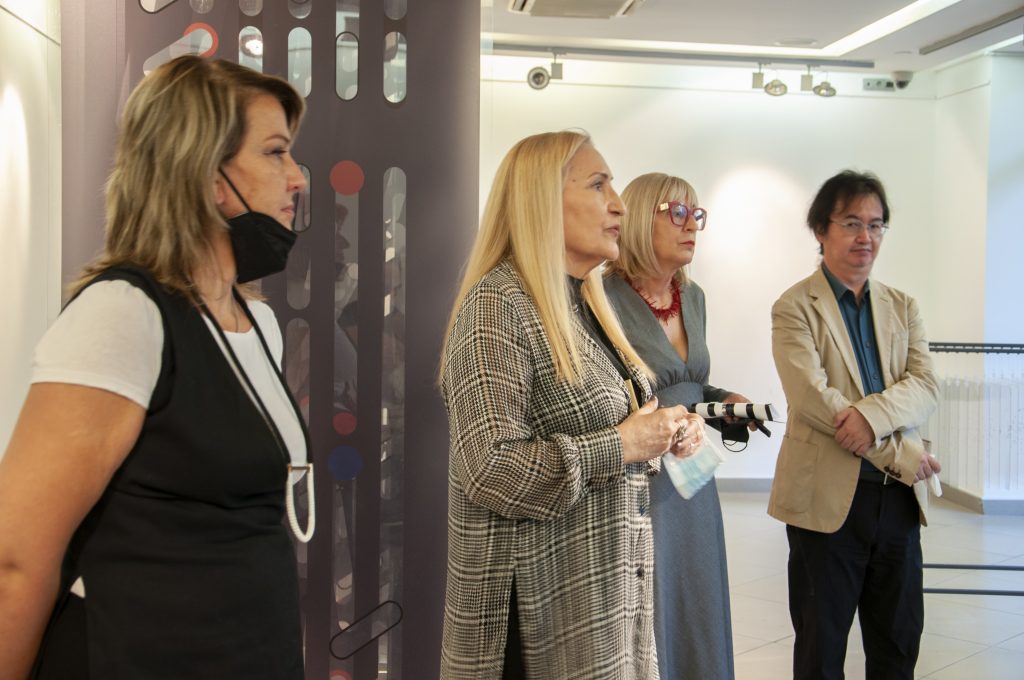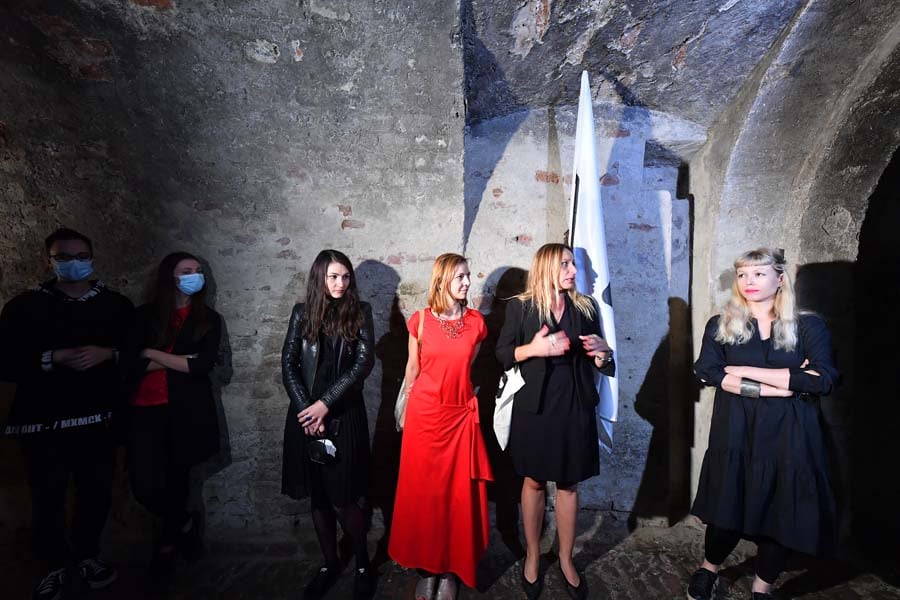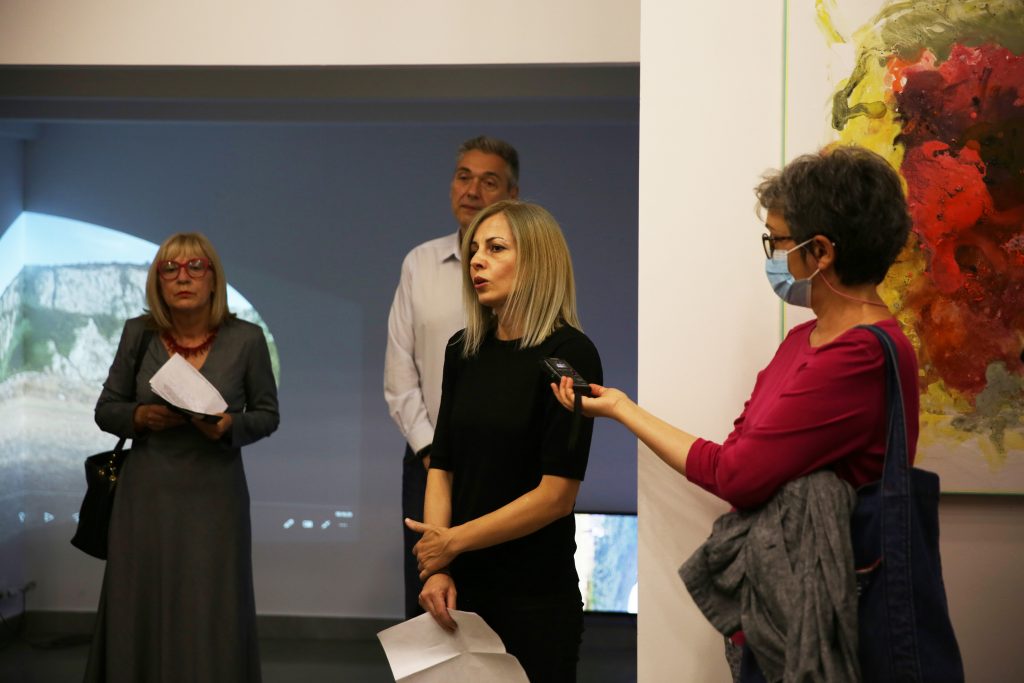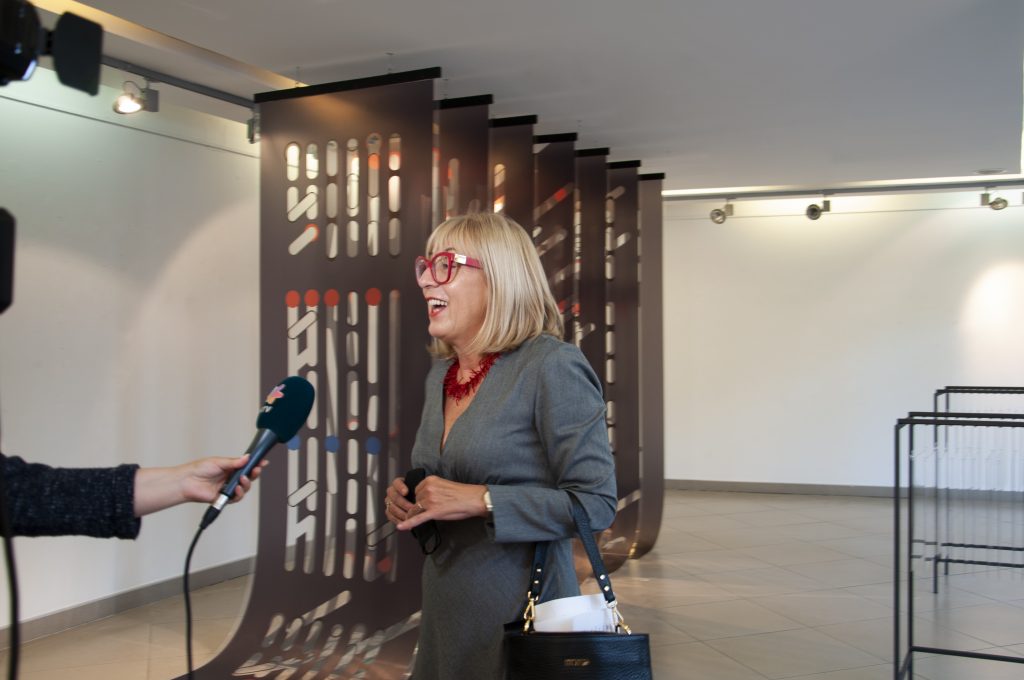
During the Festival our young associates Doroteja Antić and Aleksa Ćirić spoke to the curators of DD 2021, Svetlana Mladenov, Diana Marincu and Slavica Popov, and to the Festival Director Vesna Latinović.
You can read some of what they said here.
SVETLANA MLADENOV is a Serbian curator and art historian. At this year’s Danube Dialogues she curated an installation by Karolina Mudrinski as part of the Novi Sad+ segment. Svetlana’s career and work have always promoted contemporary art on the one hand while spotting and neutralizing obstacles to the process on the other.
DD: You’ve been working with the Danube Dialogues for several years now. Is there a difference between how they used to be organized and how they are organized now, in this “forced reality”?
SM: Organization is always complicated and exhausting, sometimes it feels like it gets harder and harder every time. Still, we continue the hard work and try to do our best, no matter how tired, insecure or stressed out we get. In my experience, in the end everything falls into place, which gives us satisfaction and encouragement to move on and continue the festival.
DD: You curated an exhibit that combines art and science. Do you think advanced knowledge of these theories is essential for the audience to experience the art in the right way?
SM: The segment that evokes a reaction from the audience is visual, understanding the scientific background is not necessary. Although Karolina Mudrinski’s work is based on one particular theory, that is not the only component that matters. If you don’t focus exclusively on that aspect, you can get a whole different experience.
DD: Do you think that the pandemic has made people around the world question their faith in science? How would you comment on the expansion of science in art and how do you think this has influenced artists and their work?
SM: I would disagree with the idea that people have lost faith in science. I believe that politics and centres of power spread doubt and that makes people inclined to question more things than they normally would. Educated people always support science, and scientists would never harm people. The problem is that many others are using the results of scientific research for promotion or other doubtful purposes. That’s why we are constantly surrounded by huge amounts of information, which are sometimes the exact opposite of information.
DD: Serbia is still a country in transition. How important is it for us to host festivals such as the Danube Dialogues? Has it any value for the progress of our society?
SM: I believe that it’s crucial. We did lose some important events in the past, but on the other hand that is exactly when the Danube Dialogues were founded – in a vacuum, during a period when we lacked festivals. It may have started out as a humble project, but due to the hard work and high ambitions of Sava Stepanov and Vesna Latinović, it has expanded and progressed. That helps our country not only to find its place in the region, but in the world. In order to start speaking an “international language”, we need to promote our artists and that can only be achieved through constant communication, exchange of experiences, and international cooperation. That is the main purpose of this festival.

DIANA MARINCU is a Romanian curator who chose three Romanian artists to exhibit in this year’s Novi Sad – Timisoara dialogue. The artists she selected were Oana Paula Veiner, Andrea Medar and Liliana Mercioui Popa.
DD: How would you describe working with your colleagues at the festival this year? Was the organization affected by the pandemic?
DM: Quite the contrary, in fact. It was a sort of escape from the pandemic because the organisation of the festival was so well done. From the start, we had absolutely no problems in communicating amongst ourselves. This is a real recipe for how to make something great even though there may be external factors barring your way.
DD: What would you point to as coming out of the dialogue between Novi Sad and Timisoara?
DM: Well, in the first place, some kind of bond between the two cities is a must. To start with, there is a historical thread connecting them. Secondly, neither of them is the capital of their respective countries, which in my opinion makes the art scene more vibrant and responsive, and finally both cities are to be European capitals of culture. That title and festivals such as the Danube Dialogues are a reward for both artists and organisers, a good indicator of what art is capable of doing.
DD: Is a Serbian-Romanian dialogue the future of the “Novi Sad – Timisoara” dialogue? Should it evolve in this direction or will it remain between the cities?
DM: I think that it should evolve and I encourage that. It is important to overcome geographical borders, which are actually fictitious. Cooperation benefits both sides, a sort of transaction in which everyone gains.
DD: Do you think these events contribute to a better links between the two countries?
DM: Culturally speaking, it is not good to isolate yourself. Historically speaking, Romania has in the past tried to link up with countries that are further away, but it has learned a lot from that experience. If we look around, we see that our people are more alike than we know, and that is only one of many reasons why we should continue to work together.

SLAVICA POPOV is a Serbian curator and art historian. For this year’s Danube Dialogues she chose three Serbian artists to present in a Serbia – Bulgaria dialogue, an exhibition it was also her job to curate. Her three selections were the duo DiSTRUKTURA, Ana Vrtačnik and Monika Sigeti.
DD: Have you noticed any difference between cooperation with artists before and after this “forced reality”?
SP: I believe that there is a difference, but it’s not that great. We were pushed very aggressively into this virtual world, but it doesn’t mean we have to escape from it entirely. Perhaps it would be better for us to try to find a balance between virtual reality and the reality we are used to, our own reality.
DD: Do you think that the effect of “forced reality” on artists’ work has been severe or mild? Has it made their works more similar or has it deepened the gap between them?
SP: Everyone has a different approach to the situation we’re in, but that doesn’t mean we can’t find a shared language, especially in the art world.
DD: Has “forced reality” pushed the local art scene to the fore or has it served to push it to the background?
SP: Certainly art in Serbia continues to function, our artists and curators are managing to work and communicate in this complex situation. The term “new normal” makes us all wonder what was normal in the first place, the situation before the pandemic or the one we’re in now. The impossible is now possible, which suggests that there are multiple realities, and the artist’s task is to detect them and to present that discovery in their work. If we’re observant enough, we might notice those realities, and in a way that can prepare us for future unexpected circumstances.

VESNA LATINOVIĆ, director of the Danube Dialogues festival, tells us how this ninth edition of the festival differs from previous ones, how the “forced reality” affects her, the significance of cooperation, and the most important aspects of organizing an international contemporary art festival.
DD: This is the second edition of the festival since the start of the pandemic. Are there any differences in the organisation process?
VL: In fact, there is a huge difference. Last year, we were filled with uncertainty and everything was under question. Since this is an international festival, preparations must begin months or even a year before. When the pandemic broke out, we decided to persist and go on with the preparations. Last year we had an online version of the festival standing by, just in case, but thankfully there was no need and we held a real live festival, but respecting all the anti-covid rules, of course. What struck me most last time was the number of participants, artists and curators from abroad, and how eager they were to come. This year, preparations were a little more relaxed because now we had the experience of last year. For the second year in a row, we’ve proved that art, much like life itself, can’t be stopped.
DD: How important for the festival are contacts between the Serbian Ministry of Culture and foreign embassies? Do they show how the Danube Dialogues rank on the international art scene?
VL: Without all the help we get from Serbian government agencies, the festival would not be possible, since it is not a commercial event. A demanding international festival requires significant funds and effort. Any support to the organisation is very welcome. Support from the embassies and foreign cultural centres to the artists and curators coming from these countries is very important. The Austrian Cultural Forum has been our partner from the beginning. We hope that more and more embassies will collaborate with us as this opens up a wider field of artists we can invite and work with. The festival’s reputation and presence in the media has been continuously growing. All that is the result of hard work and a strategic approach.
DD: How would you describe contacts between the Danube dialogues and their partners, or other similar festivals? In what way does that affect development of the artistic and cultural scene?
VL: I think it is essential. Every co-production means sharing work, but also sharing the satisfaction in the end. The Danube dialogues have established good connections with other festivals such as the Art Encounters Biennial in Timisoara, the Festival of Digital Art in Sofia, and as of this year, Art Electronica from Linz and Videomedeja from Novi Sad. Even though Novi Sad has a huge and vibrant festival culture, only the Danube Dialogues and Videomedeja are visual art festivals. In any case, any kind of collaboration is great for the festival, partners and participants, and it contributes to the growth of the cultural scene.
DD: What would you say is the key part of the organization, the element that may determine its success?
VL: It is very important to choose a suitable, up-to-date topic for the festival. It should be in step with what is going on in society and reflect the main issues. Our art director, Sava Stepanov, has shown that he handles that part of things extremely well. It requires great knowledge of the current art scene, of society and the directions it’s likely to take. Apart from that, it’s extremely important to choose good people to work with, not only people who are competent but who contribute to good communications and to the festival itself.
